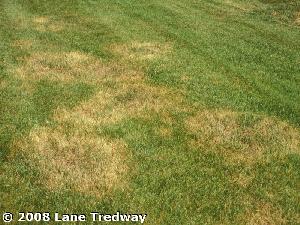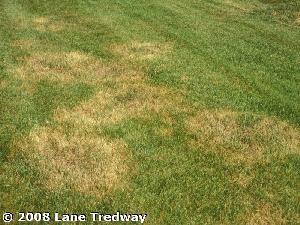5 Ways to Manage Brown Patch
Brown Patch
disease, Rhizoctonia solani, is one of the most destructive diseases in our area. It is characterized by having a smokey ring with a brown patch of turf in the center.
It favors hot, humid weather.
You can see brown patch most active in temperatures falling between 70 – 90 degrees and when the turfgrass remains wet for 8-10 hours. Depending on your turf type, this can be very easily achieved, even in times of drought, due to dew and tall turf types. Poor soil drainage, lack of air movement, shade, cloudy weather, dew, over-watering, and watering in late afternoon favor prolonged leaf wetness and increased disease severity. Brown patch is particularly severe in turf that has been fertilized with excessive nitrogen. Inadequate levels of phosphorus and potassium also contribute to injury from this disease.
All this may be bad news – but are there things we can do to help? Of course!
1. Choosing the Right Turf Type
Not all fescue seed is the same. It shouldn’t be selected that way.
If you’ve ever looked at seed varieties in your local big box store, you’ll see screaming labels touting drought resistance, disease resistance, and never have to water.
This all sounds great, but it’s NTEP accurate. NTEP is the National Turfgrass Evaluation Program. They evaluate different turf types under several different parameters to provide a database for us to utilize.
Turf Type Tall Fescue varieties showing the most brown patch resistance according to NTEP, would be Falcon V, Faith, Catalyst, Bullseye, and Falcon IV.
2. Cultural Practices
Cultural practices also have a profound effect on brown patch development. Nitrogen fertilization, irrigation, and mowing are the most important factors. Tall fescue should be mown high, between 2.5 and 3.5 inches. Mowing heights below 2.5″ increase disease development by reducing the plant’s ability to produce energy, whereas mowing heights higher than 3.5″ create a turf canopy that is dense, matted, and holds moisture for extended periods. Again, back to our causes, grass blades wet for 8-10 hours lead to disease development.
3. Irrigation
Irrigation plays an important role. Irrigation should not be applied just before sunset or just after sunrise – this will extend the duration of leaf wetness and encourage disease development. Irrigation should be applied between midnight and 6 AM to minimize day time leaf wetness. Also, irrigation should not be applied every day. Instead, irrigation should be applied “deep and infrequent”, with sufficient water to wet the entire root zone every 3 to 4 days. So you’re better to water twice a week at 45 minutes/zone, rather than 7 days a week at 10 minutes/zone.
4. Fertilization
Too much nitrogen causes a more favorable environment for brown patch severity. Nitrogen causes tall fescue to produce soft, lush leaves that are easily infected by the brown patch pathogen. Excessive leaf growth also results in a more dense canopy that holds moisture and humidity. It is important to note that nitrogen does not cause brown patch to develop, rather it makes the disease more severe. Many landscape managers are unfairly accused of causing brown patch to occur by fertilizing too much.
5. Fungicides
Even if all the appropriate steps are taken to avoid brown patch, it still may strike. We are dealing with nature, after all. So how do you manage it?
It’s best to call a professional to analyze, diagnose, and plan an appropriate course of action. Depending on the severity of the disease, fungicides may not be feasible in achieving an acceptable level of control. Sometimes environmental conditions may be so extreme that fungicides will not provide an improvement in turf quality.
Here in Knoxville, we see brown patch all too often. If you think you may have disease affecting your lawn, give us a call and let one of our trained professionals determine the correct course of action for your lawn!


